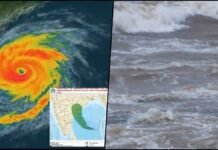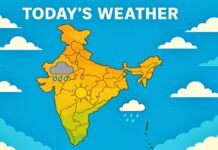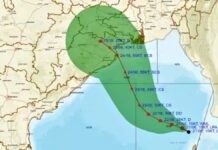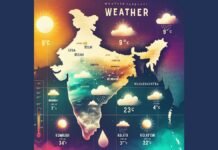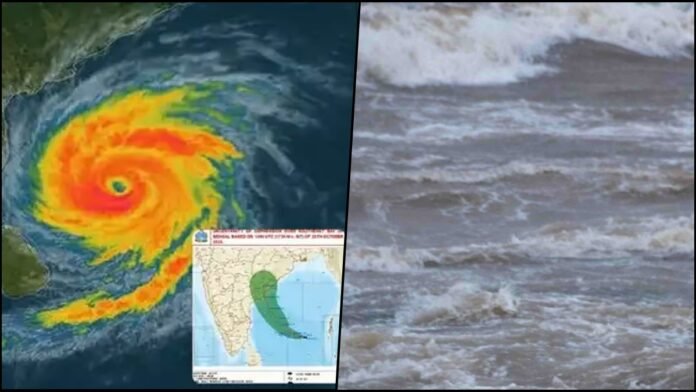
Key Points:
- Cyclone Montha made landfall near Kakinada on October 28, 2025, at 7 PM with wind speeds of 90-110 kmph
- One woman killed in Konaseema district after palmyra tree fell on her during gales
- 38,000 hectares of standing crops and 1.38 lakh hectares of horticulture crops destroyed
- Over 76,000 people evacuated to 2,200 relief camps across Andhra Pradesh
- Storm weakened to cyclonic storm by early October 29 as it moved inland
- Red alert issued in 19 coastal districts; 42 trains cancelled due to cyclone impact
- Thailand suggested the name “Montha,” meaning “fragrant or beautiful flower” in Thai
New Delhi: Severe Cyclonic Storm Montha crossed the central Andhra Pradesh coast between Tuesday night and early Wednesday, bringing maximum sustained wind speeds of 90-100 kmph with gusts reaching 110 kmph. The landfall process began at 7 PM on October 28, 2025, between Machilipatnam and Kalingapatnam, south of Kakinada, exactly as predicted by the India Meteorological Department (IMD).
The cyclone’s devastating impact resulted in the death of a woman at Makanagudem village in Konaseema district when an uprooted palmyra tree fell on her due to powerful gales. This marked the first confirmed casualty from the severe weather system that had been tracked for several days across the Bay of Bengal.
Massive Agricultural Losses
The cyclone inflicted extensive damage to agricultural land across coastal Andhra Pradesh, destroying standing crops on 38,000 hectares and horticulture crops across 1.38 lakh hectares. High tidal waves of approximately one metre above the astronomical tide inundated low-lying coastal villages, severely impacting districts including Srikakulam, Vizianagaram, Visakhapatnam, Anakapalle, Nellore, Konaseema, and Kakinada.
High tidal waves completely damaged the Uppada-Kakinada beach road, forcing authorities to close it for traffic. The cyclone’s fury uprooted numerous trees, snapped power lines across multiple districts, and disrupted electricity supply in vast areas. A wall collapsed near Malkapuram police station in Visakhapatnam due to torrential rainfall, highlighting the widespread structural damage.
Thailand’s Floral Tribute
The name “Montha” was proposed by Thailand from the rotating list maintained by 13 member countries of the North Indian Ocean region. The name derives from the Thai word meaning “fragrant or beautiful flower,” representing Thailand’s contribution to the cyclone naming system. The 13 participating countries, India, Bangladesh, Maldives, Myanmar, Oman, Pakistan, Sri Lanka, Thailand, Yemen, Iran, Qatar, Saudi Arabia, and the UAE, each submit 13 names, creating a pool of 169 designations.
These names are officially announced by India’s Regional Specialized Meteorological Center (RSMC) in New Delhi, which operates under the World Meteorological Organization (WMO) and the United Nations Economic and Social Commission for Asia and the Pacific (ESCAP). The systematic naming helps in effective communication and tracking of tropical cyclones across the region.
Extensive Evacuation Operations
The Andhra Pradesh government launched massive evacuation operations, relocating 76,000 people to 2,200 specially arranged relief camps across affected districts. The state administration took protective measures for 3,465 pregnant women and new mothers, ensuring their safety during the cyclone. Additionally, 219 medical camps were established at various locations to provide immediate healthcare assistance.
Authorities arranged 865 tonnes of animal fodder in anticipation of livestock needs during the disaster. The government suspended vehicle movement on roads in cyclone-affected districts, including Krishna, Eluru, and Kakinada, from 8:30 PM on Tuesday to 6 AM on Wednesday, exempting only emergency medical services. Control rooms were established in 54 revenue divisions across 19 districts to coordinate relief efforts.
Port Safety Measures
Maritime authorities implemented the highest safety protocols across Andhra Pradesh’s coastline. The Great Danger Signal Number 10, the highest danger signal issued during severe cyclones, was hoisted at Kakinada Port. Great Danger Signal Number 9 was displayed at Visakhapatnam, Gangavaram, Kalingapatnam, and Bheemunipatnam ports, while Signal Number 8 was raised at Machilipatnam, Nizampatnam, Krishnapatnam, and Vadarevu ports.
Fishermen across coastal areas of Andhra Pradesh, Tamil Nadu, and Puducherry received strict advisories prohibiting sea ventures until the cyclone completely dissipated. The IMD warned of storm surge conditions and extremely rough sea conditions that posed severe risks to maritime activities.
Cyclone Weakening Process
By 2:30 AM IST on October 29, Cyclone Montha weakened from a Severe Cyclonic Storm to a Cyclonic Storm as it moved inland. At that time, the system was positioned approximately 20 km west-northwest of Narsapur, 50 km northeast of Machilipatnam, 90 km west-southwest of Kakinada, and 230 km southwest of Visakhapatnam.
The IMD confirmed that the cyclone continued moving northwestwards and would maintain its strength for approximately six hours after landfall before gradually weakening into a deep depression. Doppler Weather Radars in Machilipatnam and Visakhapatnam closely tracked the system, along with data from coastal observatories, automatic weather stations, ships, buoys, and satellites.
Impact on Neighboring States
In Odisha, the cyclone’s impact was felt across 15 districts, though the state largely escaped major damage. Odisha Chief Minister Mohan Charan Majhi reported only minor incidents of landslides and uprooted trees, with rainfall significantly lower than forecast. Gajapati and Ganjam districts recorded around 115 mm of rain each, compared to earlier predictions of over 200 mm.
Gajapati District Magistrate Madhumita confirmed that 10,000 people were relocated from sensitive areas to achieve zero casualties, with pregnant women receiving special attention. In Odisha, 17,817 people were evacuated to over 2,000 cyclone shelters, against the initial plan to move 32,000 people. Importantly, no casualties were reported in Odisha, providing significant relief to state authorities.
Transportation Disruptions
The cyclone severely disrupted railway operations across the region, with authorities cancelling 42 trains, diverting 2 trains, short-terminating or short-originating 5 trains, and rescheduling 8 trains. The extensive railway network adjustments were necessary to ensure passenger safety during the severe weather conditions.
The IMD issued red alerts for 19 districts across Andhra Pradesh, warning of flash floods and continued heavy to very heavy rainfall in Krishna, East Godavari, and West Godavari districts even after the cyclone’s landfall. Orange alerts were maintained in several other districts as strong winds persisted in coastal belts.
Ongoing Relief Operations
Teams from the National Disaster Response Force (NDRF) and State Disaster Response Force (SDRF) remained actively engaged in relief and rescue operations across affected areas. The administration issued urgent appeals to the public to avoid non-essential travel and strictly follow local instructions during the cyclone’s passage.
The cyclone affected approximately 1,419 villages, 44 municipalities, and 233 mandals across Andhra Pradesh, requiring coordinated administrative responses. Heavy rainfall continued to lash several districts even after landfall, with the IMD warning of localized flooding, continued tree uprooting, and damage to houses, electric poles, and power lines.





